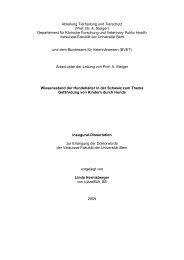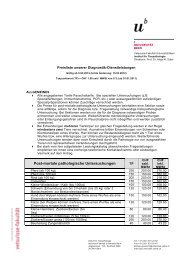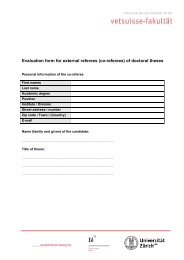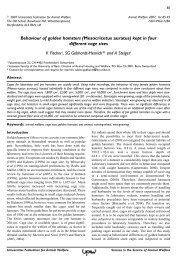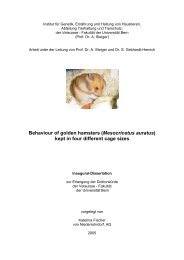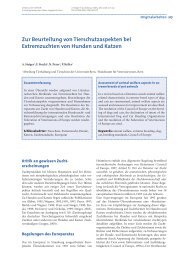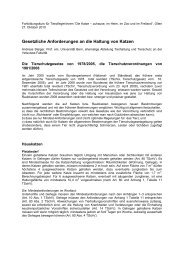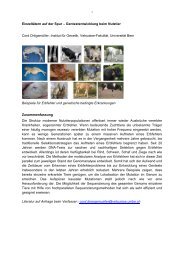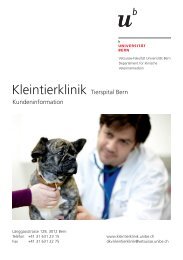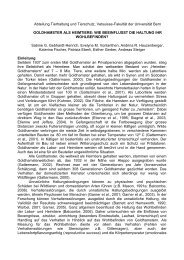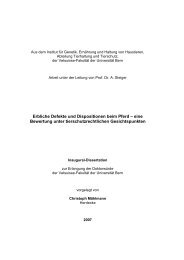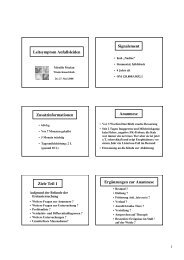Radiographic findings in several joints of nine bears
Radiographic findings in several joints of nine bears
Radiographic findings in several joints of nine bears
Create successful ePaper yourself
Turn your PDF publications into a flip-book with our unique Google optimized e-Paper software.
Age and pathology<br />
Animals with neoplasia represented 26.2% (n = 17/65) <strong>of</strong> the total set, animals suffer<strong>in</strong>g from<br />
dysfunction <strong>of</strong> the musculoskeletal system represented 36.9% (n = 24/65) and animals<br />
suffer<strong>in</strong>g from other diseases represented 36.9% (n = 24/65) (Table 7 and 8). In the group<br />
“neoplasia” 50% <strong>of</strong> the animals (n = 5/10) with “neoplasia <strong>of</strong> visceral organ” and 87.5% <strong>of</strong><br />
the animals (n = 6/7) with “neoplasia <strong>of</strong> non visceral organ” had an age equal and superior to<br />
100% <strong>of</strong> the life expectancy <strong>in</strong> the wild. In the group “other pathologies”, 100% <strong>of</strong> the<br />
animals (n = 7/7) with an age equal or superior to 100% <strong>of</strong> the life expectancy <strong>in</strong> the wild<br />
suffered either from dysfunction <strong>of</strong> the cardiovascular system or from dysfunction <strong>of</strong> the<br />
kidneys or from the liver.<br />
Table 7 Frequency <strong>of</strong> the three pathological groups <strong>of</strong> this study <strong>in</strong> correlation<br />
with an age <strong>of</strong> animals ≥ 100% <strong>of</strong> the life expectancy <strong>in</strong> the wild (%) and <strong>in</strong><br />
correlation with an age ≥ 50% <strong>of</strong> the maximal age <strong>in</strong> captivity (%)<br />
Pathologies Animals (n = 29) with an age Animals (n = 62) with an age ≥<br />
≥ 100% <strong>of</strong> the life expectancy 50% <strong>of</strong> the maximal age <strong>in</strong><br />
<strong>in</strong> the wild (%)<br />
captivity (%)<br />
Neoplasia 36.6% 25.0%<br />
Dysfunction <strong>of</strong> the<br />
musculoskeletal system<br />
39.0% 34.4%<br />
Other pathologies 24.4% 40.6%<br />
Table 8 Frequency <strong>of</strong> all animals <strong>of</strong> this study with the same group <strong>of</strong> pathology <strong>in</strong><br />
correlation with an age <strong>of</strong> animals ≥ 100% <strong>of</strong> the life expectancy <strong>in</strong> the wild (%) and<br />
<strong>in</strong> correlation with an age ≥ 50% <strong>of</strong> the maximal age <strong>in</strong> captivity (%)<br />
Pathologies Animals (n = 29) with an age ≥<br />
100% <strong>of</strong> the life expectancy <strong>in</strong> the<br />
wild (%)<br />
All animals with neoplasia 73.3% 81%<br />
All animals with dysfunction <strong>of</strong><br />
the musculoskeletal system<br />
All animals with other<br />
pathologies<br />
75% 81.8%<br />
60% 84.6%<br />
Animals(n = 62) with an age ≥<br />
50% <strong>of</strong> the maximal age <strong>in</strong><br />
captivity (%)<br />
<strong>Radiographic</strong> exam<strong>in</strong>ation <strong>of</strong> anesthetized animals<br />
Four brown <strong>bears</strong> (U. arctos) and one polar bear (U. maritimus) showed mild lameness, gait<br />
abnormalities or paraparesis, and one brown bear (U. arctos) showed severe lameness.<br />
Radiographs showed none to mild osteoarthritic changes <strong>in</strong> the elbow jo<strong>in</strong>ts <strong>of</strong> four <strong>bears</strong>. In<br />
the brown bear (U. arctos) with severe lameness severe osteoarthritis was diagnosed <strong>in</strong> both<br />
elbow jo<strong>in</strong>ts. Concern<strong>in</strong>g the hip jo<strong>in</strong>t, five <strong>bears</strong> with mild lameness showed none<br />
radiographic alterations, and the radiographs <strong>of</strong> the brown bear (U. arctos) with severe<br />
lameness revealed severe osteoarthritic alterations. The stifle jo<strong>in</strong>t <strong>in</strong> one brown bear (U.<br />
arctos) was not exam<strong>in</strong>ed. Three <strong>bears</strong> had mild to moderate osteoarthritis <strong>in</strong> the stifle jo<strong>in</strong>t<br />
and the bear with severe lameness had moderate osteoarthritic changes. Furthermore, three<br />
<strong>bears</strong> showed enthesiophytes <strong>in</strong> the right patella proximally. One bear showed enthesiophytes<br />
<strong>in</strong> the left patella proximally and one other bear showed enthesiophytes <strong>in</strong> the left patella<br />
proximally and distally. One stifle <strong>in</strong> a brown bear (U. arctos) with gait abnormalities showed<br />
changes consistent with osteochondromatosis. The same bear showed an extraarticular bone<br />
lesion consistent with an enostosis-like lesion <strong>in</strong> the tibia. Radiographs showed mild<br />
22



